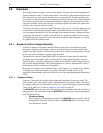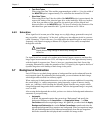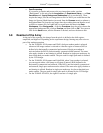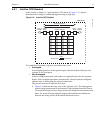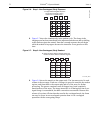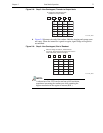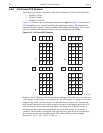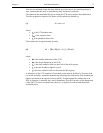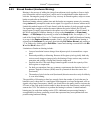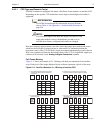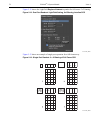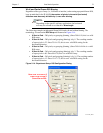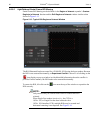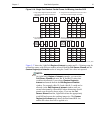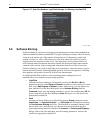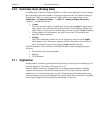
76 PI-MAX
®
4 System Manual Issue 4
5.8.3 Binned Readout (Hardware Binning)
Binning is the process of adding the charge from adjacent pixels together to form a single
pixel (sometimes called a super-pixel,) and it can be accomplished in either hardware or
software. Rectangular groups of pixels of any size may be binned together, subject to some
hardware and software limitations.
Hardware binning reduces readout time and the burden on computer memory by summing
charge
before the preamplifier reads out the signal. For signal levels that are readout noise
limited this method improves S/N ratio linearly with the number of pixels grouped together.
For signals large enough to render the camera photon shot noise limited, the S/N ratio
improvement is roughly proportional to the square-root of the number of pixels binned. In
the WinX application, hardware binning is set up on the
Acquisition —> Experiment
Setup… —> ROI Setup
tab by entering a value in the Group fields: for example, a “2” in
each of the Group fields will set up 2 x 2 hardware binning. In LightField, hardware binning
is set up via the
Region of Interest expander, first by verifying that hardware binning is
selected on the
Advanced fly-out pane, then selecting Full Sensor Binned, and entering a
“2” in fields or by clicking on the
Edit ROIs… button and creating a custom ROI with Bin
W
and the Bin H values of “2”.
Limitations of hardware binning include:
• Lowered resolution because charge from adjacent pixels is summed into a super
pixel.
• Increased possibility to blooming. Because shift register pixels typically hold only
twice as much charge as image pixels, the binning of large sections may result in
saturation and spilling of charge back into the image area
• Possible data loss if the total charge binned together exceeds the capacity of the
shift register or output node.
• For dual port operation, there are symmetry requirements that limit the choice of
patterns. Regions of interest (ROIs) must be symmetrical about the center line
(horizontal.)
• The number of pixels in the serial (horizontal) direction must be evenly divisible by
4, even after binning.
The possibility of blooming or data loss strongly limits the number of pixels that may be
binned in cases where there is a small signal superimposed on a large background, such as
signals with a large fluorescence. Ideally, one would like to bin many pixels to increase the
S/N ratio of the weak peaks but this cannot be done because the fluorescence would quickly
saturate the CCD. The solution is to perform the binning in software. Limited hardware
binning may be used when reading out the CCD. Additional post-processing binning is
accomplished in software, producing a result that represents many more photons than was
possible using hardware binning.



